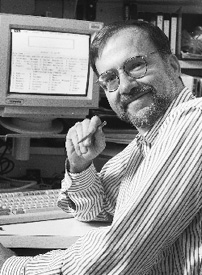Our Science – Shaw Website
J. Stephen Shaw, M.D.
 |
|
|||||||||||||||||||||
Biography
Dr. Shaw received his B.A. from Harvard College and his M.D. from Harvard Medical School. After his pediatric residency at the University of Minnesota, he came to the NIH where he has conducted basic research in human immunology. Among other scientific and editorial advisory boards, he serves on the Scientific Council of the International Workshops on Human Leukocyte Differentiation Antigens. He has a longstanding interest in the use of computers to facilitate biological research and information sharing. Among his awards is the Public Health Service Exceptional Capabilities Promotion.
Research
Mechanisms of Human Cellular Immune Responses
Historically, our laboratory has made fundamental contributions to the understanding of human T lymphocyte adhesion, migration, activation, and differentiation. Our current emphasis is on molecular understanding of T cell responses to acute stimulation by chemokines and by T cell receptor-mediated signals; areas of particular emphasis are cytoskeletal reorganization and the phosphorylation cascades involved in transducing these signals.
Lymphocyte cytoskeleton is the framework that orchestrates and controls many aspects of lymphocyte signaling, as well as adhesion and migration. We are investigating the organization of lymphocyte cytoskeleton and its reorganization during acute lymphocyte responses. Our recent contributions in this area include the following: We have discovered a cage-like organization of vimentin intermediate filaments in resting T cells and demonstrate that this system is a major contributor to lymphocyte resistance to deformation, previously ascribed to other filament systems. We have also discovered that plectin, best known in epithelial cells, is expressed in lymphocytes and that this huge protein is a key contributor to their intermediate filament organization. Vimentin, plectin, and fodrin are physically interconnected in lymphocytes; this 'VPF' assembly spans all the way from the nucleus to the plasma membrane and condenses into the uropod within 1 min of chemokine stimulation. We have been elucidating central roles played by serine/threonine phosphorylation cascades in cytoskeletal reorganization. Understanding individual phosphorylation/dephosphorylation events is a powerful way to dissect this complex process, as illustrated by our studies of moesin phospho-Thr-558 (pT558), one of five phosphorylation sites we have identified in the chemokine response. We have demonstrated that moesin is acutely dephosphorylated early in chemokine stimulation, resulting in resorption of microvilli and other key structural changes in cytoskeletal organization.
Serine/threonine phosphorylation cascades are critical both to cytoskeletal reorganization and to antigen-specific stimulation of T cells. However, few S/T phosphorylation sites have been identified that are critical early participants in T-lymphocyte stimulation by chemokine and/or antigen. We have initiated systematic approaches to identify such sites, especially those that are substrates for protein kinase C (PKC) or related basophilic kinases. One key element in our strategy is a novel approach we have pioneered to determine peptide specificity of kinases using positional scanning of oriented peptide libraries. Results with this method in studies of PKC demonstrate specificity and sensitivity (80-90%) much better than previous predictive methods. Our findings and our new visual representation of peptide specificity highlight the importance of disfavored residues, whose role has previously been underappreciated. Our results demonstrate a very strong role of peptide specificity per se in determining which sites in the proteome are phosphorylated by PKC. We are now using those predictions to facilitate identification of novel physiologically important phosphorylation events in T-lymphocytes.
To efficiently conduct these studies, we have developed resources to serve both ourselves and others. We are developing a novel computer-based approach in which information about biological systems is stored in an unusually simple and coherent way. Utilization of this software has been indispensable in synthesizing data on the many elements (genes, transcripts, proteins, domains, phosphorylation sites, drugs, knock-out mice, references, etc.) that are pertinent to our ongoing studies. We are also developing computational tools for protein sequence and structure analysis to facilitate analysis of kinases and their substrate specificity.
This page was last updated on 7/14/2008.

